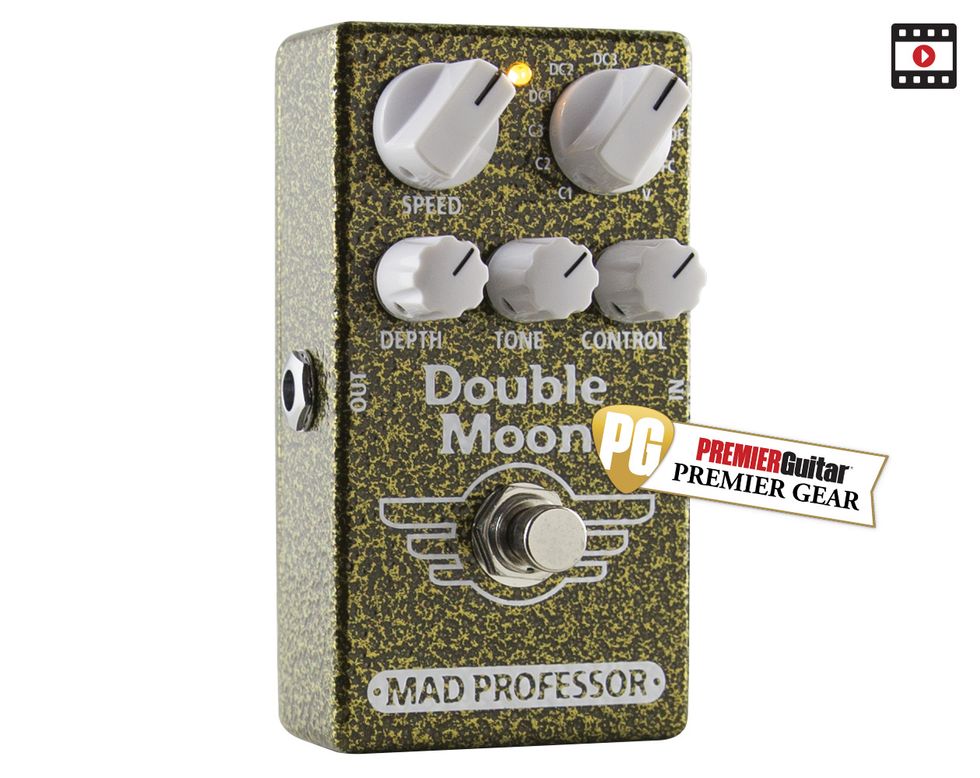RatingsPros:Warm modulation sounds. Handily tweakable yet simple to operate. Compact size. Cons: Snorkely midrange in standard tuning. Street: $289 Mad Professor Double Moon mpamp.com | Tones: Ease of Use: Build/Design: Value: |
Mad Professor is one of my favorite pedal makers. One of the company’s underrated Bluebird overdrive/delay units sits at the center of my main pedalboard. So I was excited about the release of their Double Moon, which is essentially a modulation workstation housed in a compact pedal.
The analog, bucket-brigade-driven Double Moon uses digital control to manipulate 11 different modulation sounds: three choruses, three dual choruses, two flangers, one dual flanger, a flanger and chorus in parallel, and one vibrato. For a small-format analog pedal, that’s a wealth of possibilities.
Modulation Management
Double Moon’s control panel is simple. There are knobs for speed and depth, like you see on just about any modulation pedal, but there’s also a tone knob—a major bonus on a multi-modulation device where peaks in intensity are bound to vary. A rotary switch selects from the 11 modes, while a knob labeled “control” serves varying functions, depending on the effect chosen. Generally speaking, you’ll need the manual to sort out what it’s governing for each effect, but you get a feel for how the functions vary from mode to mode pretty quickly. Regardless, the various available parameters—which range from LFO waveform to regeneration—enable major changes to each voice.
Mild to Wild
The Double Moon’s sonic options range from subtle to over-the-top. They’re also too numerous to cover completely in the space of this review. But it bears mentioning that the most fundamental and conventional sounds are excellent and a measure of how good some of the more out-there fare is, too. In C2 mode, I was treated to lush, balanced chorus perfect for arpeggiating chord shapes that incorporate open strings, like on Metallica’s “Welcome Home (Sanitarium).” I also summoned a really nice Mike Stern-style chorus that enriched complex jazz chords—especially with a bump to the control setting, which adjusts the LFO waveform in C2 mode. In fact, the beauty of the throbbing, almost tremolo-like effects made me wish you could bask in them even more with proper stereo separation. Unfortunately, lack of dual outputs might be the Double Moon’s only real letdown.
C3 generated faux-Leslie sounds that would be awesome for comping in a jam band, especially in a dual-guitarist scenario where contrasting sounds are a plus. It’s a great setting that inspires modal and quartal chord moves like a keyboard player. F2, meanwhile, serves up flanger sounds ideal for underwater, single-note, Nirvana-style riffs. Though the control knob, which functions here as regeneration, can also transform the modulations into a steady, pulsating chirp like an old-school analog flanger.
The Verdict
If you’re a DSP-averse guitarist who loves having a multitude of modulation possibilities, Mad Professor’s Double Moon is a killer pedal to consider for your next pedalboard addition. It’s small. It’s analog. And the digital control is smart and streamlined. I particularly loved the choruses, but each of the effects is out of this world.
Watch the First Look:








![Rig Rundown: Russian Circles’ Mike Sullivan [2025]](https://www.premierguitar.com/media-library/youtube.jpg?id=62303631&width=1245&height=700&quality=70&coordinates=0%2C0%2C0%2C0)


























